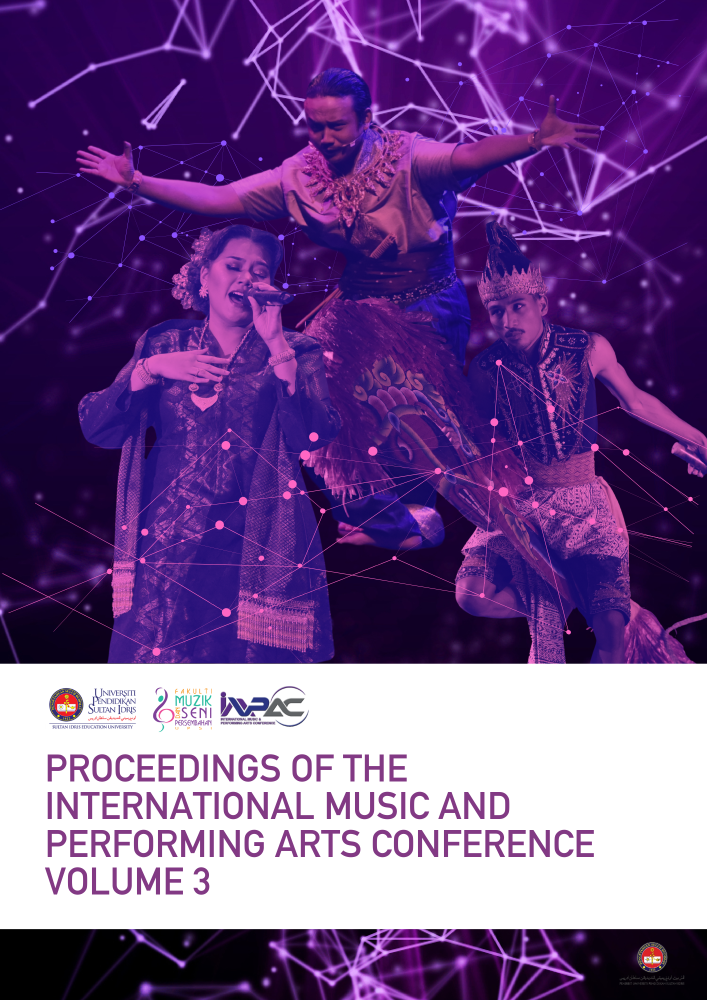Langue and Parole Analysis on Aesthetic Setting of ‘The Last Emperor of Tang Dynasty’ Musical Theatre
DOI:
https://doi.org/10.37134/impac.v3.2.2025Keywords:
Chinese culture, langue and parole, musical theatreAbstract
A theatrical performance on a large-scale open stage needs a sound visual appearance in all its scenography elements such as the backdrop, costume, lighting and props. Due to its distance between the audience and stage is quite far, strong aesthetic elements with profound symbolic meaning are needed to ease the audience to understand and engage with the story. ‘The last Emperor of Tang Dynasty’ is a musical theatre performed daily in Xi’an recites the historical tragedy between Emperor Xuanzong of Tang and her favourite concubine, Yang Guifei. It is staged at Huaqing Hill, the original site of the ancient palace built in 723rd c. The backdrop includes the actual hill at the back of the stage, a large screen in the middle that displays different montage for different scenes. In front of the stage that acts as the middle stage shows the depth and scale of the castle, whereby the pool in front is also used as a ‘wet’ stage. The wet stage represents the bathing ground for the concubine and sometimes used as water curtain during scene change replacing curtains. In this study, the researcher will analyse the aesthetic elements displayed throughout the show that contain semiotic meanings of langue and parole in its design elements like colours and form. As the theatre performance has limited time to present the details of each character or events, it is vital to represent emotions or scene using impactful visuals to assist audience’s understanding about the story or characters. Thus, this study is made to analyse on how these elements works as the langue and parole to emphasize the two. The combination of langue and parole derived from other cultures had enhanced the storyline and enhanced the audience understanding towards the whole performance. The deviation of meaning from the original context in Chinese culture to universal parole of visual language evident the acceptance of Chinese culture to other visual langue and parole which had elevated the musical theatre to a higher level.
Downloads
References
Chen, X. (2001, September 1). A stage in search of a tradition: The dynamics of form and content in post-Maoist theatre. University of Hawaii Press, 18(2), 200-221. https://doi.org/10.1353/atj.2001.0014
Chilton, G. (2024, January 24). Everything you need to know about Chinese colors and their meanings. Retrieved from Preply: https://preply.com/en/blog/chinese-colors/
Colours Combo. (n.d.). What does the colour black mean in China? Retrieved November 9, 2024, from https://colourscombo.com
Crozier, W. R. (1999). The meanings of colour: Preferences among hues. Pigment & Resin Technology, 28(1), 6-14.
Daniel, E. (2018, October 28). The story of Tang Emperor Xuanzong and mistress Yang Guifei. Retrieved from EmmanuelDaniel.com: https://www.emmanueldaniel.com/the-story-of-tang-emperor-xuanzong-and-mistress-yang-guifei/
Elliot, A. J., & Maier, M. (2012, January 1). Colour-in-context theory. Elsevier BV, 61-125. https://doi.org/10.1016/b978-0-12-394286-9.00002-0
Fischer–Lichte, E. (2008, January 1). Sense and sensation: Exploring the interplay between the semiotic and performative dimensions of theatre. 22(2), 69-81. https://doi.org/10.1353/dtc.2008.0001
Hsu, D. M. (1964, January 1). Musical elements of Chinese opera. Oxford University Press, L(4), 439-451. https://doi.org/10.1093/mq/l.4.439
Kwong, M. (2017, July 4). Colours in Chinese culture: What do they mean and symbolise. Mabel Kwong. Retrieved November 9, 2024, from https://mabelkwong.com/2017/07/04/colours-in-chinese-culture-what-do-they-mean-and-symbolise/
Liu, S. (2018, January 1). The great traditional/modern divide of regional Chinese theatrical genres in the 1950s. Johns Hopkins University Press, 70(2), 153-172. https://doi.org/10.1353/tj.2018.0025
Logan-Clarke, V., & Appleby, J. (2009). What is colour therapy? Colour therapy healing workshops. Bognor Regis, UK.
McLean, S. (2023, October 7). The color yellow: Essential color theory, symbolism and design application. Retrieved from Dunn Edwards: https://www.dunnedwards.com/pros/blog/the-color-yellow-essential-color-theory-symbolism-and-design-application/
O’Connor, Z. (2009). Colour psychology and colour therapy: Caveat emptor. Colour Research and Application, 229-234.
Okafor, M. U. (2020). Chinese colour symbolism. Odezurugbo Journal, 215-225.
The Colors of Peking Opera. (2024, November 10). Retrieved from China Culture.org: http://en.chinaculture.org/library/2008-01/24/content_46854_2.htm
Verot, O. (2023, July 10). The symbolism of colors in China. Retrieved from GMA: https://marketingtochina.com/symbolism-colors-china/
Downloads
Published
Issue
Section
License
Copyright (c) 2025 Hanisa Hassan, Nerosti Adnan, Muhammad Fazli Taib Saearani, Sun Zenyu (Author)

This work is licensed under a Creative Commons Attribution 4.0 International License.
Authors retain copyright and grant the Proceedings of the International Music and Performing Arts Conference (IMPAC Proceedings) the right of first publication.
This licence permits unrestricted use, distribution, and reproduction in any medium, provided the original work is properly cited.





